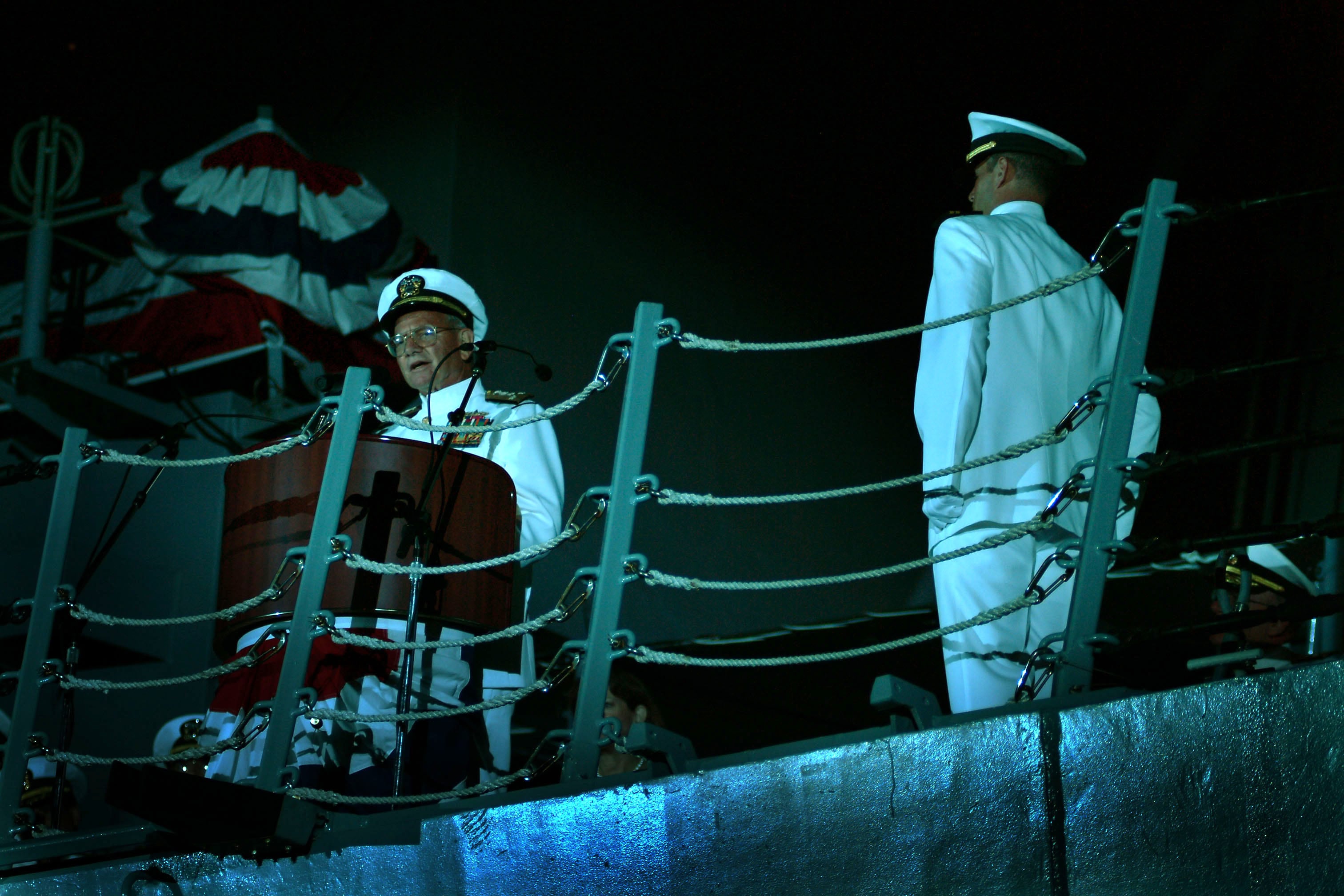Retired Vice Adm. Henry Mustin, a combat veteran and fleet boss renowned for his tactical brilliance and demanding leadership style and who hailed from one of the Navy's most storied families, has died. He was 82.
Vice Adm. Henry "Hammerin’ Hank" Mustin died of congestive heart failure April 11 and will be mourned Thursday at the U.S. Naval Academy, where he graduated as a fifth generation naval officer in 1955.
A career surface warfare officer, Mustin oversaw the development of many of the ship and guided missile systems that are at the heart of the fleet's power. Nicknamed "Hammerin' Hank," he was known was as known for his fierce intellect and had a tough demeanor to match it, said Capt. Rick Hoffman, a retired cruiser captain who interacted with him when Mustin was head of the Atlantic Fleet.
"He was very highly regarded on the waterfront as a war-fighter," Hoffman recalled, adding that when briefing Hammerin' Hank on a program or upcoming exercise, you had to be on your game or risk a tongue-lashing.
Capt. John Mustin, Mustin’s son, said his father expected excellence from his subordinates and that if an officer knew his or her business, he’d be the first to praise them. But if he didn’t think the officer was bringing his or her best, he could be hard to work for, a statement Hoffman agreed with. Those who brought their "A" game loved working for him.
Mustin was named for his grandfather, the pioneering aviator Capt. Henry C. Mustin, naval aviator No. 11 who developed the catapult launch concept and was the first aviator to be launched from the deck of an underway warship. He founded Naval Air Station Pensacola, Fla., and was the first head of headed and was the first man to be catapulted from the deck of a Navy ship and was the first head of Naval Air Forces Pacific.
He was the son of Vice Adm. Lloyd Mustin, who fought in the battle of Guadalcanal and who helped develop the lead-computing anti-aircraft gun sight, which made a huge impact in the battles of World War II.
A Vietnam veteran, Hammerin’ Hank was a pioneer in his own right who had a huge influence in shaping today’s fleet. As head of Navy’s Surface Combat Systems division in the Pentagon, he led the development of the Tomahawk missile, the Standard missile, the Light Airborne, Multi-Purpose System helicopters, and the Ticonderoga-class cruisers. He also worked on the early development of the Arleigh Burke-class destroyers.
And while he was a distinguished officer ashore, John Mustin recalled his father was happiest at sea and commanding sailors. Mustin commanded the minesweeper Bunting, destroyer Henry B. Wilson, Destroyer Squadron 12, Cruiser Destroyer Group 2 and 2nd Fleet. He served in Vietnam with Delta River Patrol Group.
"His favorite job was destroyer CO," John Mustin said. "He felt it was the perfect level combining his tactical proficiency and capability while still maintaining a relationship with his crew. When he was a fleet commander, he didn't feel he had the integration with the sailors that he did when he commanded the Henry B. Wilson."

Retired Vice Adm. Henry Mustin, left, prepares to set the first watch aboard the destroyer Mustin in 2003, a ship named in his family's honor. Mustin died April 11 at age 83.
Photo Credit: PHC (AW) Johnny Bivera/Navy
During his 34-year career, Mustin received two Distinguished Service Medals, three Legions of Merit, three Bronze Star Medals with Combat 'V,' the Meritorious Service Medal, the Air Medal with gold star and Combat 'V,' and the Combat Action Ribbon, as well as many other personal awards and campaign and service medals.
Mustin graduated from the Naval Academy in 1955 and was also enormously proud of his time at the Naval Academy, and was active in the leadership of the alumni association.
"The Navy was a huge part of him," his son said. "His service in uniform really defined him and he continued that work even after he retired."
John Mustin, who has been selected for promotion to rear admiral pending confirmation, isn’t the only Mustin from more recent generations to have servedthe current crop with Navy ties. His brother and sister-in-law are both retired captains and his nephew is a lieutenant.
The destroyer Mustin is named for the family's remarkable legacy.
The Navy’s top officer offered his condolences in a statement and praised his extraordinary service.
"From as far back as the 1800's, the Mustin family name has been synonymous with a legacy of service in our Navy," said Adm. John Richardson, chief of naval operations, in a statement. "His forward-leaning approach to warfighting was instrumental in the development of numerous shipboard and weapons technologies. … Vice Admiral Mustin took strong hold of the naval legacy passed to him by both his father and grandfather, cementing into history a continued family drive for ingenuity and service to country.
"Our thoughts and prayers are with his wife Lucy, the entire Mustin family and the countless shipmates that mourn his loss. He will be greatly missed," Richardson said.
Funeral services will be held at the US Naval Academy Chapel in Annapolis, MarylandMD on Thursday, April 28th at 10:00 a.m.AM. In lieu of flowers, memorial donations may be made to the USNA Foundation for the Athletic Excellence Fund, 25 Maryland Avenue, Annapolis, MD 21401, or The Sentara Foundation – Hampton Roads, Sentara Heart Fund, 6015 Poplar Hall Drive, Suite 308, Norfolk, VA 23502.
David B. Larter was the naval warfare reporter for Defense News.




